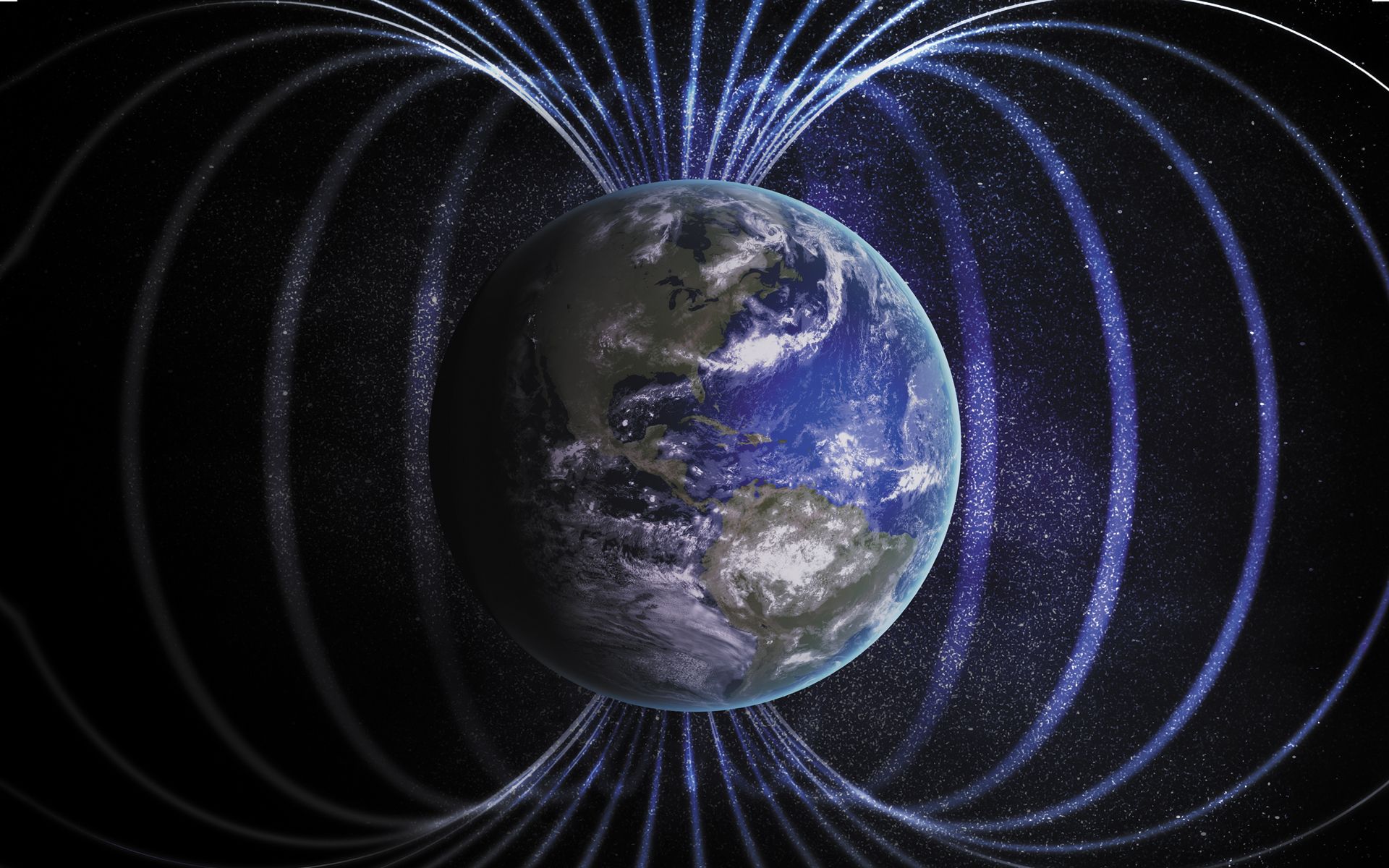Earth's Magnetic Jacket

In This Article
-
How is the Earth protected from solar winds of high-energy charged particles?
-
Earth is a giant magnet, with a magnetic field running around it from the South pole to the North pole.
-
Mars lost its magnetic field about 4 billion years ago. This loss made Mars vulnerable against solar winds which consequently stripped the planet’s atmosphere and evaporated the oceans and all the water.
When we look around us at the world of the living, “protection” appears to be an essential component of survival. Animals are equipped with various mechanisms to protect themselves from the harms of the environment or other predators. Cats have claws and fur to avoid cold, chameleons use camouflage, a skunk gives off an odor for defense, and a turtle has a hard shell to protect its vital organs. The peel of an orange keeps its inside fresh until consumed. While other animals are born with defense mechanisms and quickly learn to use them, humans are the weakest in self-defense for a long time after birth. However, using our intellect, we can make clothing and build shelters to protect ourselves from the cold or heat. Defense mechanisms seem to prevail and vary throughout the universe. Did you know that our planet Earth also has a defense mechanism like a jacket or a windbreaker that keeps us safe from a damaging storm?
It is now well-established that space is not entirely empty or inactive. In fact, there are strong winds of particles, mainly composed of electrons and protons, that fly out from the Sun and travel throughout space. This phenomenon is called "solar wind" and it reaches our planet Earth. This wind of high-energy charged particles travels at very high speeds, such as 500,000 km per second, and can be highly harmful [1]. In fact, when astronauts go to space, a significant factor they need to take into consideration is the “space weather” which is largely dictated by the solar wind. If these particles reach the Earth, they can cause static electricity to build up everywhere, disrupt communications, and interfere with electric power distribution. Over time, these winds are estimated to cause serious health effects on humans, such as cancer or death. Since we have not actually been subjected to this wind directly, we don’t exactly know the level of the harm; but even in the most optimistic scenario, life on Earth would cease to exist in a relatively short amount of time.
So, how come we are never impacted by this high-speed storm and never even feel its existence? Our planet has a defensive tool provided by the Earth’s magnetic field. A magnetic field can be considered like invisible lines of forces surrounding an object, acting like a magnet. For instance, consider the everyday magnets that we hang on the sides of our refrigerators at home. These magnets attract or repel certain metals through a force we call magnetic force. This magnetic force is active even without physical contact between the magnet and the metal.
Physicists explain this force in terms of the concept of a “field”– a field can be thought of as invisible lines surrounding an object. Consider the magnetic field of a regular magnet. If a magnetic material, such as a metal, enters this region of the field, the interaction between the field and the metal produces a force based on the laws of electromagnetism. This force results in the attraction or repulsion of the metal by the magnet, depending on their orientation.
In essence, our Earth is a giant magnet, with a magnetic field running around it from the South pole to the North pole. This is how compasses work: the tiny needle in a compass is pushed by the Earth’s magnetic field until it aligns with the field direction. Since the Earth’s magnetic field always points toward the North pole, so does a compass needle. That is why a compass needle always point towards the geographic direction of North.
A key feature of a magnetic field is that it acts on particles with electrical charge, such as electrons or ions. For example, when an ion gets close to a magnet and enters its magnetic field, the ion is subjected to a force that changes its direction of motion, causing it to follow a different path. This effectively diverts the ion from its original trajectory. This is exactly what happens when the solar wind approaches us, the Earth. The ions that make up the solar wind travel at extremely high speeds and would otherwise have a significant impact. However, when they enter the magnetic field of the Earth, they are pushed away from their original path, preventing the solar wind from reaching the surface of the Earth. Essentially, the magnetic field of the Earth acts like a protective jacket or windbreaker that repels the solar wind and safeguards life on Earth.
Lorentz force equation
Interestingly, as the charged particles are diverted from their initial path by the magnetic field, they mainly enter the atmosphere near the poles. This is an obvious result of what is called the “Lorentz force equation” which forms the foundation of electromagnetism. As part of the solar wind enters through the poles, they ionize the air and free up electrons which in turn recombine with other atoms. This process releases energy in the form of light at different wavelengths (colors) which forms the spectacular aurora borealis sometimes called “northern lights.” The sky is filled with beautiful colors forming an image pleasing to the eye. Basically, the Earth’s magnetic field not only impedes the storm but also transforms it into a colorful image as if it is trying to transform even harmful phenomena to the benefit of humans.
To see how crucial a magnetic field can be, consider our neighboring planet Mars which is believed to have retained a magnetic field similar to that of ours. It is now accepted that Mars lost its magnetic field about 4 billion years ago. Although the exact mechanism leading to the disappearing of Mars’ magnetic field is not evident, there are theories asserting that the loss was mainly due to the changes in the chemical structure of the planet’s core. This loss made Mars vulnerable against solar winds which consequently stripped the planet’s atmosphere and evaporated the oceans and all the water that would be crucial for life. [2,3] This alone proves us how vital the Earth’s magnetic field is as it is one of the many factors that make life possible on our blue planet.
The fact that our Earth has been assigned with such a shield by a “Protector” is a good enough reason to be thankful.
Lord of the heavens and the earth, and everything between them; and Lord of the Easts. We have adorned the lower heaven with the beauty of the planets. And guarded it against every defiant devil. (As-Saffat 37:5-7).
References
- https://www.jpl.nasa.gov/nmp/st5/SCIENCE/solarwind.html
- Nature Communications, Volume 13, Article number: 644 (2022)
- Proceedings of the National Academy of Sciences of the United States of America, Vol. 117, No. 50 (December 15, 2020), pp. 31558-31560









